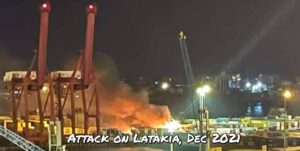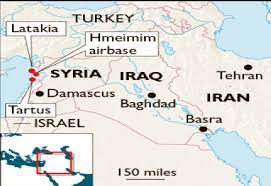by Neville Teller
When the news broke on December 7 that the Syrian port of Latakia had been bombed, and that an Israeli military spokesperson had declined to comment, a natural first reaction was that this air strike was the latest of hundreds over the past few years, targeting Syrian government facilities in receipt of Iranian-supplied military hardware. Although Latakia port is a vital gateway into Syria for goods of all kinds, it had not featured as a main reception point for Iranian weaponry, and had not been attacked in the past. Perhaps intelligence had revealed suspect cargo arriving from Iran.
Then warning lights began flashing in the media. Weren’t Latakia and the Russian military somehow connected? Was this attack much more dangerous than at first appeared? Was Israel sailing too close to the wind?
The key to the delicate situation lies in the Russian military presence in Syria. Close Russo-Syrian relationships go back a long way – as far back as July 1944, two years before the French finally withdrew and Syria was an independent state. Soviet support sustained the new nation in its early years, and in 1971 Syria’s then president, Hafez al-Assad, granted the USSR permission to open a naval military base in the port city of Tartus, giving it a presence in the Mediterranean and easy access to the Suez Canal. To bolster their close connection, in 1980 Syria and the Soviet Union signed a Treaty of Friendship and Cooperation. With the Russian Federation recognized by Syria as the legal successor to the Soviet Union, that treaty remains in operation to this day.
This intimate relationship, secured by pact, played an important part in the decision by Russian president Vladimir Putin to back Syria’s Bashar al-Assad from the start of the Syrian civil war, and later in Russia’s military intervention in 2015 in support of Assad against the groups seeking a democratic future for their country. It also explains how Putin was able to consolidate, and later extend, his military presence in Syria.
When Putin intervened in the fighting, Russian air cover was located in the airbase at Hmeimim, which is situated in Latakia province, about 15 miles south-east of Latakia city. During a surprise visit to Hmeimim in December 2017, Putin announced that he had signed a new 49-year deal with the Syrian government. Russia’s air base at Hmeimim, together with its naval facility in Tartus, were to be expanded and could henceforth be used “on a permanent basis.”
A glance at the map of Syria’s Mediterranean coastline shows Latakia, Hmeimim and Tartus running north-south down a 52-mile stretch of coast road. In short Russia’s vital naval and air bases in Syria are literally within striking distance of Latakia port, hit by airstrikes in the early hours of December 7.
Although Israel rarely acknowledges or discusses such operations, it is generally accepted that Israel has staged hundreds of strikes on targets inside government-controlled Syria over the years. What Israel does say is that its strikes on Iran-provided facilities and weapons inside Syria are justified to protect its citizens on the country’s northern borders, and that it attacks arms shipments it believes are bound for Syrian government forces, Hezbollah or Iranian-backed militias. Israel rarely launches strikes close to the permanent Russian military and naval bases in government-controlled Syria.
The situation may appear alarming, with the potential to spiral out of control, but there is in fact a system in place aimed at avoiding any accidental clashes between Israel and Russia in Syria.
Back in September 2015 then-prime minister, Benjamin Netanyahu, visited Putin in Moscow. Briefing Israeli reporters after the meeting, Netanyahu said he had come with the aim of preventing misunderstandings between IDF and Russian forces in Syria, and that he and Putin had “agreed on a mechanism to prevent such misunderstandings”. They had decided that to avoid accidentally trading fire in Syria, their military activity would be coordinated.
That understanding was confirmed as recently as October, when prime minister Naftali Bennett met Putin in Sochi. They agreed that the two nations would continue to implement the so-called “deconfliction mechanism” that prevents Israeli and Russian forces from clashing in Syria. Housing minister Ze’ev Elkin, who accompanied Bennett, confirmed that the “very wide” talks regarding the situation in Syria were focused on “safeguarding the coordination mechanism.”
The media reported that during the meeting Putin agreed to Israel maintaining its freedom of action in Syria, but had asked for additional advanced warning of strikes.
There is little doubt. therefore, that had Israel intended to bomb Latakia port on December 7, Russian military intelligence would have been informed well in advance, and that their nearby airbase at Hmeimim would have been in no danger. A safeguard system is up and running, but the potential for disaster lies just a human error away – as, for example, in 2018 when a Syrian air defense gunner, aiming for Israeli jets on a bombing run, downed a Russian military plane instead, killing all 15 people on board.
Until Syria can be stabilized and disconnected from Iran’s baleful involvement, avoiding a potentially disastrous military clash between Russia and Israel is dependent on the current precarious arrangements. The main consolation is that they have not failed, so far.
The writer is Middle East correspondent for Eurasia Review. His latest book is: “Trump and the Holy Land: 2016-2020”. Follow him at: www.a-mid-east-journal.blogspot.com


